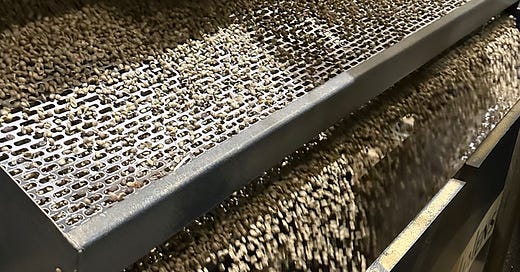Coffee Being Sorted, in Brazil - Photo Taken by the Author
The question last Fall was whether the usual, historically coffee-friendly weather patterns would return to Brazil after a 100 day drought. The answer, for now, seems to be yes. The weather system that developed last year maintained a soil-parching high pressure zone over almost all of Brazil’s coffee-growing areas. That pattern has now dissipated and the usual precipitation has returned.
The next question was whether the crop was going to proceed normally or if the yield after milling might be exceptionally low due to last year’s drought. This is important, here, because such a development could be specifically attributable to climate change, rather than to more typical weather variations. We don’t have an answer on this yet. So far, it’s looking like the drought last year might have significantly impacted the pending crop’s yield. We’ll know more after the coffee from the 24/25 crop has been all milled. Last week, Brazil’s largest co-op, Cooxupe, reported that they were less than 20% through their milling — so this year’s yield is still unknown, for that Co-op and the for the nation.
Why does it matter if the reason for tight supplies of coffee now and going forward are due to random weather events or to climate change? Because if it is Climate Change-related that means that the current weather patterns may mark new norms that must be regularly considered, rather than transient anomalies that cannot be anticipated.
Daniel Neves, CEO of the green coffee importer, Cape Horn Coffee, pointed out to me that the differential price of Brazil’s under-grade “grinders” is about 45 under as of this writing. Dan is concerned that this relatively low level may indicate that the current crop is yielding a surplus of this grade, which would necessarily be at the expense of the larger screen sorts that may end up as no-shows later this summer.
The point here, though, is not to predict the price of coffee three months from now, but to better understand whether or not Climate Change is making the world a less hospitable place for growing coffee. The tentative answer here is yes, but not as fast as we feared last year when Brazil’s drought was in full swing.
In the meantime, many of us have grown bored with a high market, or at least that was my sentiment several days ago and, indeed, the thing has dropped almost 50+ cents since. Dan cautions, though, that while concerns on the supply side are more-or-less known, the demand side is more murky; we really don’t know how coffee drinkers, world-wide will digest the recent bout of high prices, once those new levels (percolate?) out to retail – despite the valiant efforts of retailers to deny them entry. In the U.S., in particular, it’s also hard to know if the import tariff on coffee will affect demand; so far, it seems not.
Climate scientists have successfully predicted changes in weather patterns for years now. The incremental changes have followed those prognostications pretty closely. If anything, the forecasts have proven to be conservative. However, we have not seen the epochal changes that some researchers say are inevitable — the shutdown of the Gulf Stream is probably one of the most well known. Such a change in Brazil’s weather patterns is also possible, but not one we’ve yet seen, either. While it can be argued as to whether those more dramatic effects will ever occur, (but only because they haven’t yet — most researchers and scientists are sure that they will) it does seem fairly certain that a new set of variables, those attributable to climate change, should now be added to the formulae used to predict annual coffee production.
If only it were that simple — current price levels and the world economy in general make the demand side no less complex. The overall Climate for Coffee, is, well, cloudy.
https://www.huffpost.com/entry/coffee-extinction_n_2104187













Share this post